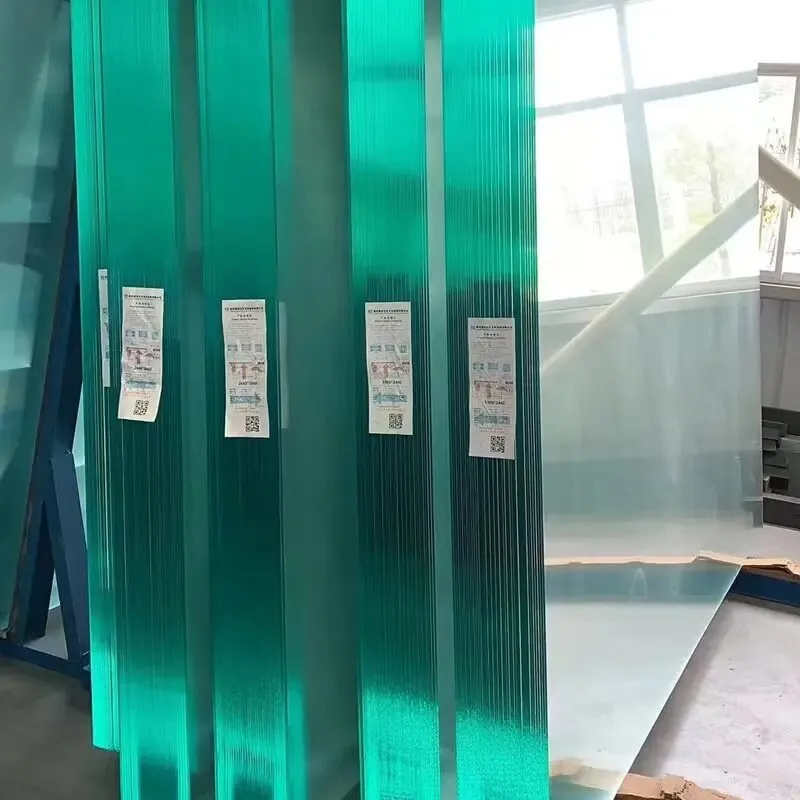The float glass manufacturing process stands as a pivotal innovation in the architectural and automotive industries, renowned for its ability to produce uniform and clear flat glass. With roots tracing back to the mid-20th century, the process has become both an art and a science, requiring precise expertise and mastery of technological advances to meet contemporary demands for quality and efficiency.

Understanding the intricacies of float glass manufacturing begins with the raw materials. A blend primarily consisting of silica sand, soda ash, lime, dolomite, and various other components such as alumina, is carefully combined. Each material plays a specific role—silica provides the necessary network for the glass, soda ash reduces the melting temperature, and lime contributes to the chemical durability of the final product.
The journey of creating float glass starts in the furnace, where the raw material mix is gradually melted at approximately 1700 degrees Celsius. This is a critical step in the process, requiring deep understanding and control to ensure the melt is homogenous. Any deviation during this stage can lead to imperfections in the float glass, underscoring the necessity for expertise in furnace operations.

Once the molten glass reaches the desired molten state, it is guided onto a bath of molten tin, an ingenious innovation that ensures the glass achieves a perfectly flat and uniform surface. This stage of the process highlights the artful balance between gravity and surface tension, attributes that need continual monitoring and adjustments. Operators skilled in observing the qualities of the flowing glass make precise changes, maintaining the sheet’s thickness and surface quality.
As the glass floats along the tin bath, it gradually cools under controlled conditions. This cooling phase is vital, dictating the internal stresses, optical clarity, and mechanical strength of the final product. With an understanding rooted in experience, operators can anticipate and adjust for variations that could impact the final glass quality, ensuring consistency that meets stringent industry standards.
float glass manufacturing process
Following the float bath, the glass enters an annealing lehr. This elongated oven is where the glass is slowly cooled through a series of controlled temperature zones to relieve the internal stresses introduced during the manufacturing process. Expertise in this phase is essential; it determines the glass's durability and its suitability for subsequent cutting, polishing, and further processing.
Upon exiting the annealing lehr, the float glass undergoes rigorous inspection. Advanced technologies, such as automated optical scanners, detect defects invisible to the naked eye. This meticulous inspection process ensures that only glass of the highest quality proceeds to the market, reflecting the authority of manufacturers in delivering reliable and premium products.
One of the critical advantages of float glass is its versatility. From clear and tinted to coated and treated variants, it finds application in a variety of products, including windows, mirrors, and solar panels. The ability to produce such diverse products from a single process illustrates the operational excellence and trustworthiness developed over decades within the industry.
Manufacturers continually invest in research and development to optimize the float glass process, incorporating sustainable practices such as recycling cullet (crushed glass) back into the furnace, reducing energy consumption, and lowering emissions. Such advances are not only environmentally responsible but also economically advantageous, ensuring the long-term sustainability and competitiveness of the industry.
In conclusion, the float glass manufacturing process is a testament to human ingenuity and industrial craftsmanship. Mastery of this process requires a commitment to excellence and a deep understanding of the interplay between technology, materials, and human skills. As the architectural and automotive industries evolve, the demand for high-quality float glass will continue to grow, bolstered by ongoing innovations and the unwavering dedication of professionals committed to advancing the art of glassmaking.
 Afrikaans
Afrikaans  Albanian
Albanian  Amharic
Amharic  Arabic
Arabic  Armenian
Armenian  Azerbaijani
Azerbaijani  Basque
Basque  Belarusian
Belarusian  Bengali
Bengali  Bosnian
Bosnian  Bulgarian
Bulgarian  Catalan
Catalan  Cebuano
Cebuano  Corsican
Corsican  Croatian
Croatian  Czech
Czech  Danish
Danish  Dutch
Dutch  English
English  Esperanto
Esperanto  Estonian
Estonian  Finnish
Finnish  French
French  Frisian
Frisian  Galician
Galician  Georgian
Georgian  German
German  Greek
Greek  Gujarati
Gujarati  Haitian Creole
Haitian Creole  hausa
hausa  hawaiian
hawaiian  Hebrew
Hebrew  Hindi
Hindi  Miao
Miao  Hungarian
Hungarian  Icelandic
Icelandic  igbo
igbo  Indonesian
Indonesian  irish
irish  Italian
Italian  Japanese
Japanese  Javanese
Javanese  Kannada
Kannada  kazakh
kazakh  Khmer
Khmer  Rwandese
Rwandese  Korean
Korean  Kurdish
Kurdish  Kyrgyz
Kyrgyz  Lao
Lao  Latin
Latin  Latvian
Latvian  Lithuanian
Lithuanian  Luxembourgish
Luxembourgish  Macedonian
Macedonian  Malgashi
Malgashi  Malay
Malay  Malayalam
Malayalam  Maltese
Maltese  Maori
Maori  Marathi
Marathi  Mongolian
Mongolian  Myanmar
Myanmar  Nepali
Nepali  Norwegian
Norwegian  Norwegian
Norwegian  Occitan
Occitan  Pashto
Pashto  Persian
Persian  Polish
Polish  Portuguese
Portuguese  Punjabi
Punjabi  Romanian
Romanian  Russian
Russian  Samoan
Samoan  Scottish Gaelic
Scottish Gaelic  Serbian
Serbian  Sesotho
Sesotho  Shona
Shona  Sindhi
Sindhi  Sinhala
Sinhala  Slovak
Slovak  Slovenian
Slovenian  Somali
Somali  Spanish
Spanish  Sundanese
Sundanese  Swahili
Swahili  Swedish
Swedish  Tagalog
Tagalog  Tajik
Tajik  Tamil
Tamil  Tatar
Tatar  Telugu
Telugu  Thai
Thai  Turkish
Turkish  Turkmen
Turkmen  Ukrainian
Ukrainian  Urdu
Urdu  Uighur
Uighur  Uzbek
Uzbek  Vietnamese
Vietnamese  Welsh
Welsh  Bantu
Bantu  Yiddish
Yiddish  Yoruba
Yoruba  Zulu
Zulu 


